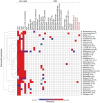Genomic analysis of Salmonella isolated from surface water and animal sources in Chile reveals new T6SS effector protein candidates
- PMID: 39723139
- PMCID: PMC11669294
- DOI: 10.3389/fmicb.2024.1496223
Genomic analysis of Salmonella isolated from surface water and animal sources in Chile reveals new T6SS effector protein candidates
Abstract
Type VI Secretion Systems (T6SS), widely distributed in Gram-negative bacteria, contribute to interbacterial competition and pathogenesis through the translocation of effector proteins to target cells. Salmonella harbor 5 pathogenicity islands encoding T6SS (SPI-6, SPI-19, SPI-20, SPI-21 and SPI-22), in which a limited number of effector proteins have been identified. Previous analyses by our group focused on the identification of candidate T6SS effectors and cognate immunity proteins in Salmonella genomes deposited in public databases. In this study, the analysis was centered on Salmonella isolates obtained from environmental sources in Chile. To this end, bioinformatics and comparative genomics analyses were performed using 695 genomes of Salmonella isolates representing 44 serotypes obtained from surface water and animal sources in Chile to identify new T6SS effector proteins. First, T6SS gene clusters were identified using the SecreT6 server. This analysis revealed that most isolates carry the SPI-6 T6SS gene cluster, whereas the SPI-19 and SPI-21 T6SS gene clusters were detected in isolates from a limited number of serotypes. In contrast, the SPI-20 and SPI-22 T6SS gene clusters were not detected. Subsequently, each ORF in the T6SS gene clusters identified was analyzed using bioinformatics tools for effector prediction, identification of immunity proteins and functional biochemical prediction. This analysis detected 20 of the 37 T6SS effector proteins previously reported in Salmonella. In addition, 4 new effector proteins with potential antibacterial activity were identified in SPI-6: 2 Rhs effectors with potential DNase activity (PAAR-RhsA-NucA_B and PAAR-RhsA-GH-E) and 2 effectors with potential RNase activity (PAAR-RhsA-CdiA and RhsA-CdiA). Interestingly, the repertoire of SPI-6 T6SS effectors varies among isolates of the same serotype. In SPI-19, no new effector protein was detected. Of note, some Rhs effectors of SPI-19 and SPI-6 present C-terminal ends with unknown function. The presence of cognate immunity proteins carrying domains present in bona fide immunity proteins suggests that these effectors have antibacterial activity. Finally, two new effectors were identified in SPI-21: one with potential peptidoglycan hydrolase activity and another with potential membrane pore-forming activity. Altogether, our work broadens the repertoire of Salmonella T6SS effector proteins and provides evidence that SPI-6, SPI-19 and SPI-21 T6SS gene clusters harbor a vast array of antibacterial effectors.
Keywords: Chile; Salmonella; T6SS; effector; immunity protein.
Copyright © 2024 Amaya, Blondel, Reyes-Méndez, Rivera, Moreno-Switt, Toro, Badilla, Santiviago and Pezoa.
Conflict of interest statement
The authors declare that the research was conducted in the absence of any commercial or financial relationships that could be construed as a potential conflict of interest.
Figures







Similar articles
-
Deciphering the Salmonella T6SS toolkit: two decades of research decoding a versatile bacterial weapon.J Bacteriol. 2025 Jul 24;207(7):e0018825. doi: 10.1128/jb.00188-25. Epub 2025 Jun 13. J Bacteriol. 2025. PMID: 40511914 Free PMC article. Review.
-
Identification and distribution of new candidate T6SS effectors encoded in Salmonella Pathogenicity Island 6.Front Microbiol. 2023 Aug 17;14:1252344. doi: 10.3389/fmicb.2023.1252344. eCollection 2023. Front Microbiol. 2023. PMID: 37664116 Free PMC article.
-
Identification of Type VI Secretion Systems Effector Proteins That Contribute to Interbacterial Competition in Salmonella Dublin.Front Microbiol. 2022 Feb 10;13:811932. doi: 10.3389/fmicb.2022.811932. eCollection 2022. Front Microbiol. 2022. PMID: 35222335 Free PMC article.
-
Comparative genomic analysis uncovers 3 novel loci encoding type six secretion systems differentially distributed in Salmonella serotypes.BMC Genomics. 2009 Aug 4;10:354. doi: 10.1186/1471-2164-10-354. BMC Genomics. 2009. PMID: 19653904 Free PMC article.
-
Secretome analysis of Vibrio cholerae type VI secretion system reveals a new effector-immunity pair.mBio. 2015 Mar 10;6(2):e00075. doi: 10.1128/mBio.00075-15. mBio. 2015. PMID: 25759499 Free PMC article.
Cited by
-
Deciphering the Salmonella T6SS toolkit: two decades of research decoding a versatile bacterial weapon.J Bacteriol. 2025 Jul 24;207(7):e0018825. doi: 10.1128/jb.00188-25. Epub 2025 Jun 13. J Bacteriol. 2025. PMID: 40511914 Free PMC article. Review.
References
-
- Amaya F. A., Blondel C. J., Barros-Infante M. F., Rivera D., Moreno-Switt A. I., Santiviago C. A., et al. . (2022). Identification of type VI secretion systems effector proteins that contribute to interbacterial competition in Salmonella Dublin. Front. Microbiol. 13:811932. doi: 10.3389/fmicb.2022.811932, PMID: - DOI - PMC - PubMed
LinkOut - more resources
Full Text Sources

